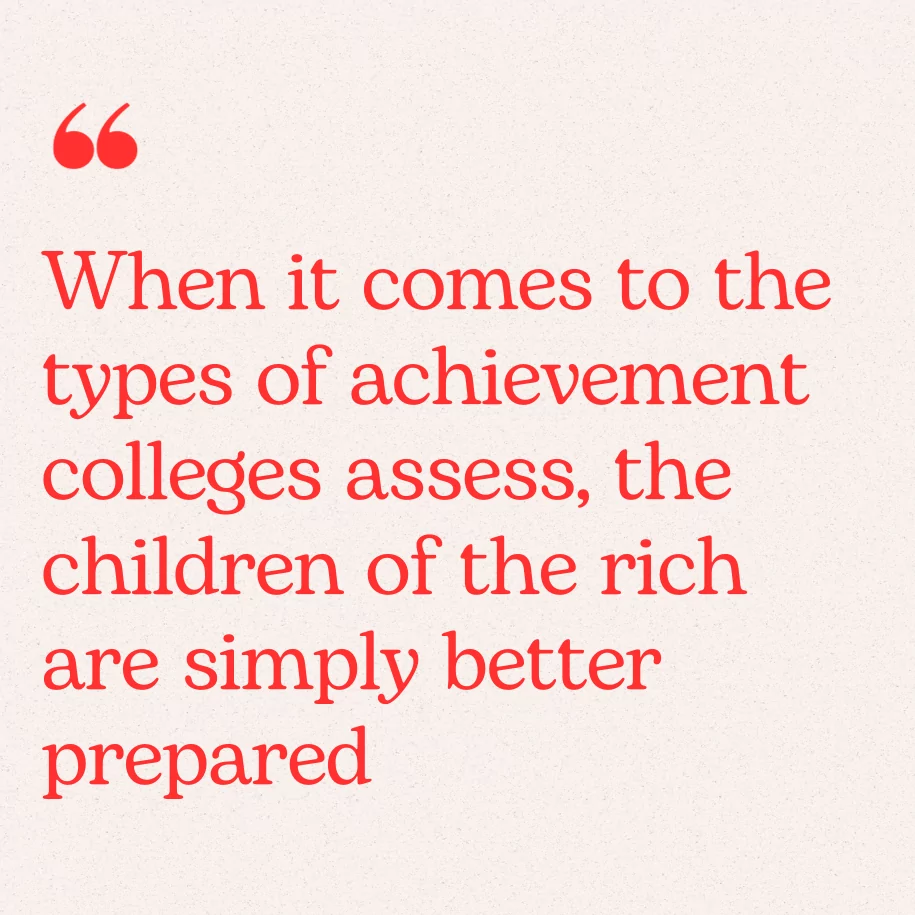Recent data, sourced from economists at Opportunity Insights based at Harvard, displays alarming statistics on the performance of students based on their family’s economic background.

✅ AI Essay Writer ✅ AI Detector ✅ Plagchecker ✅ Paraphraser
✅ Summarizer ✅ Citation Generator
Key Takeaways:
- Students from wealthier families score significantly higher on standardized tests like the SAT.
- Disparities between rich and poor students’ education start long before the college application process.
- Children of the very wealthy are overrepresented at elite colleges, in part due to better preparation for standardized tests.
Breaking Down the Numbers
Recent data, sourced from economists at Opportunity Insights based at Harvard, displays alarming statistics on the performance of students based on their family’s economic background. It was found that one-third of children from the wealthiest families scored 1300 or higher on the SAT, in contrast to less than 5% of middle-class students. Moreover, a mere one in five children from the country’s poorest families even took the test.
These findings, which will take on even more significance considering that the the SATs will be different next year, were backed by a comprehensive analysis matching students’ SAT and ACT scores from 2011, 2013, and 2015 with their parents’ income tax records from the prior six years. This data uncovers an unsettling truth.

The Root of the Problem
Many factors contribute to these disparities, but a significant one is the inequality at the core of American education. Early on, children from varying economic backgrounds receive vastly different levels of education, both in and out of school. As Professor Sean Reardon from Stanford Graduate School of Education explains, children from disadvantaged backgrounds are “behind the starting line even when they get to kindergarten.”
The external factors that children from affluent families benefit from — like attending elite private schools, engaging in expensive extracurriculars, or hiring high-end college prep services — are often out of reach for the majority. As Ann Owens, a professor of sociology at the University of Southern California, observes, parents with more disposable income often invest it in their children’s education, whether that’s through relocating to wealthier school districts or affording private tutors.
Neighborhood Segregation
Another key concern raised by the data is the segregation of neighborhoods. Children are more likely to grow up in areas of concentrated wealth or poverty. Such segregation affects the quality of schools available to them. Rich parents, having more resources, are often deeply involved in their children’s schools, which can include everything from classroom volunteering to fundraising. This creates a ripple effect, where the academic achievements and aspirations of children are influenced not just by the quality of their school but also by the people and resources surrounding them.
The “Shadow Education” Phenomenon
While the disparities in formal education settings are significant, the differences in informal learning experiences, often termed “shadow education”, are just as consequential. High-income families can afford to provide their children with myriad learning opportunities outside of school, such as museum visits, science camps, or specialized tutoring. This amplifies the learning gap between rich and poor students, as highlighted by the data on SAT scores.
Unfortunately, children from poorer families face more challenges that can hinder their academic progress. From food insecurity to the lack of stable housing, these obstacles can have lasting impacts on their academic achievements and future prospects.
To address the issue effectively, researchers advocate for a more holistic approach, focusing on younger children and advocating for universal pre-K, increased funding for schools in impoverished areas, and policies aimed at reducing residential segregation. Addressing these issues can pave the way for a more equitable future for all students, irrespective of their economic backgrounds.
Strategies for Bridging the Achievement Gap in American Education
The growing divide in students’ achievements based on socioeconomic backgrounds is a pressing concern. However, several strategies could help bridge this gap, ensuring all students receive an equitable education regardless of their family’s financial status.
- Universal Pre-K: Introducing and making pre-kindergarten education accessible for all students, irrespective of their socio-economic background, can set a strong foundation. Early education has proven to be instrumental in determining future academic achievements.
- Mentorship Programs: Pairing students with mentors who guide them through their academic journey can provide invaluable support. These mentors can offer academic guidance, emotional support, and exposure to opportunities otherwise unknown to students.
- Tailored Educational Resources: Offering schools in economically disadvantaged areas access to customized resources that cater to their students’ unique needs can help address the disparities in learning outcomes.
- Community Involvement: Engaging communities in the educational process can ensure a more holistic learning environment. Local businesses, organizations, and community members can offer internships, workshops, and real-world experiences that complement classroom learning.
- Teacher Training and Development: Investing in continuous training and development for educators ensures they are equipped with the latest pedagogical methods and strategies to cater to the diverse needs of their students.
- After-School Programs: These can provide additional academic support, particularly for students who might not have access to resources like private tutoring. Beyond academic help, these programs can also offer a safe space and essential life skills.
- Financial Aid and Scholarships: Ensuring that students from lower-income families have access to financial resources can reduce the financial strain and allow them to pursue higher education without prohibitive costs.
- Holistic Education Reform: Addressing the achievement gap requires a holistic approach. Reforms should not only focus on academic curriculum but also on fostering an inclusive environment that addresses the emotional and psychological needs of students.
By implementing these strategies, the American education system can take significant strides in closing the achievement gap and ensuring every student, regardless of their background, has the opportunity to succeed.
Follow us on Reddit for more insights and updates.





Comments (0)
Welcome to A*Help comments!
We’re all about debate and discussion at A*Help.
We value the diverse opinions of users, so you may find points of view that you don’t agree with. And that’s cool. However, there are certain things we’re not OK with: attempts to manipulate our data in any way, for example, or the posting of discriminative, offensive, hateful, or disparaging material.